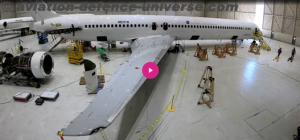- Design collaboration with NASA builds on Boeing’s sustainable aviation efforts
- 3D scanning to inform X-66 engineering design and build
- MD-90 wings will soon be removed, Transonic Truss-Braced Wings installed
Palmdale, California. 08 January 2024. Boeing has begun extensive modification of an airplane that will become the X-66 Sustainable Flight Demonstrator (SFD), removing engines and completing 3D metrology scans to inform the plane’s design and build plan.
The MD-90 jet’s original wings will soon be removed to test the Transonic Truss-Braced Wing (TTBW) design with new ultrathin wings braced by struts with larger spans and higher-aspect ratios. TTBW’s wider wing span and aerodynamic efficiency could significantly accelerate opportunities to reduce fuel use and emissions.

The X-66 is NASA’s first experimental plane project focused on helping the U.S. achieve its goal of net-zero aviation greenhouse gas emissions. Ground and flight testing is expected to begin in 2028.
Boeing released a time-lapse video of recent steps in the conversion including:
- Removal of the engines and thrust reversers
- Jacking and shoring of the jet to simulate the condition of the airplane during full modification
- 3D laser scanning of the airplane structure
With the scanning data, Boeing will use 3D modeling software to overlay the existing MD-90 structure with the new X-66 components, enabling more accurate spatial integration and the opportunity to identify and mitigate risks early in the modification process.
Boeing will continue to provide updates as the project progresses.

































































































































